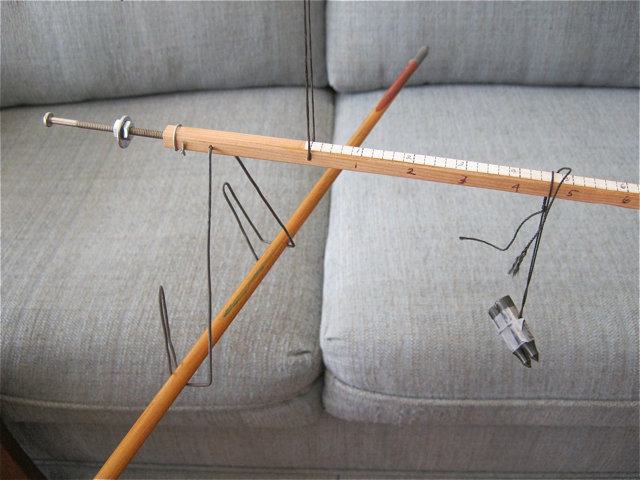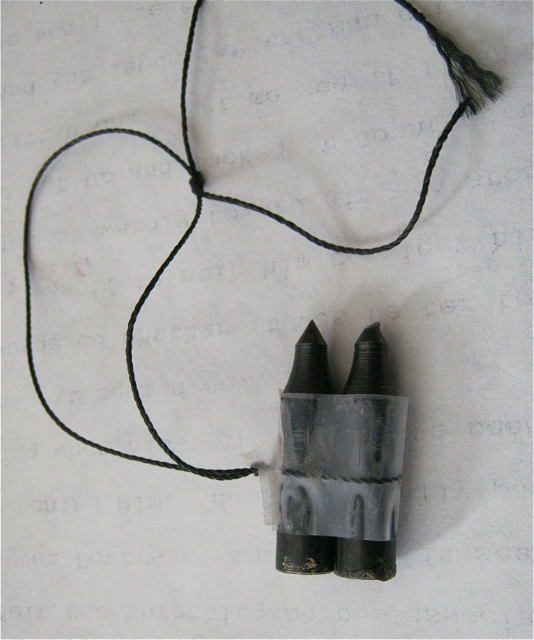
by Dick Baugh
January 2, 2014
We arrow makers always like to have our arrows as uniform as possible even though our lack of skill as archers is the main source of missing the target. This very simple balance beam scale, Figure 1, is patterned after one I saw on a YouTube video (Part I, Part II and Part III) on the construction of traditional Japanese bamboo arrows. Typically arrows are weighed in grains (7000 grains per pound). The scale works by sliding the reference weight along the beam until it exactly balances the arrow. The wire hanger for the arrow is placed two length units from the pivot point and the reference weight is 200 grains. Consequently an arrow weighing 400 grains would be exactly balanced by sliding the reference until it is 4 units away from the pivot. Simple.

Figure 1: The balance in use.

Figure 2: The 200 grain reference weight.
The reference weight, shown in Figure 2, consists of two 100 grain field points taped together. Another alternative is to borrow someone’s accurate digital arrow scale and trim a piece of wire until it weighs exactly 200 grains. Newly minted American coins have specific weights that could also be used for checking the accuracy of your scale after you make it. If your scale is off by a few percent don't worry about it. The important thing is that all your arrows are similar in weight. How close in weight do they have to be? More later. You can check the accuracy of your balance by either comparing it with a commercial arrow scale or weighing new coins. For example, a quarter weighs 87.49 grains, so a stack of 5 quarters is 437.5 grains.
Penny = 38.58 grains
Nickel = 77.15
Dime = 35.00
Quarter = 87.49

Figure 3: The zero balance adjustment.
You can draw the marks on the balance beam by hand (boring and not very accurate) or you can use your computer and printer to print out a scale such as the one supplied below. I used Courier New font, 8 point to print the scale. The overall length of the balance beam is about 8 inches for a range of 0 to 900 grains.
Suspend arrow here
--
--
--
--
0
--
--
--
--
Pivot point
--
--
--
--
100 (grains)
--
--
--
--
200
--
--
--
--
300
--
--
--
--
400
--
--
--
--
500
--
--
--
--
600
--
--
--
--
700
--
--
--
--
800
--
--
--
--
900
E-mail your comments to "Richard A. Baugh" at richardbaugh@att.net
We hope the information on the PrimitiveWays website is both instructional and enjoyable. Understand that no warranty or guarantee is included. We expect adults to act responsibly and children to be supervised by a responsible adult. If you use the information on this site to create your own projects or if you try techniques described on PrimitiveWays, behave in accordance with applicable laws, and think about the sustainability of natural resources. Using tools or techniques described on PrimitiveWays can be dangerous with exposure to heavy, sharp or pointed objects, fire, stone tools and hazards present in outdoor settings. Without proper care and caution, or if done incorrectly, there is a risk of property damage, personal injury or even death. So, be advised: Anyone using any information provided on the PrimitiveWays website assumes responsibility for using proper care and caution to protect property, the life, health and safety of himself or herself and all others. He or she expressly assumes all risk of harm or damage to all persons or property proximately caused by the use of this information.
© PrimitiveWays 2017